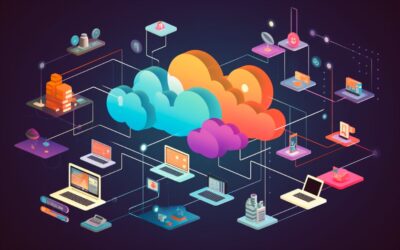To carry out a digital transformation project, reliance on new technologies should be a no-brainer. Which ones should be used? How do you go about it? To understand this new digital environment, we’ve analyzed the latest “Tech Trends” report from Deloitte. In this report, Deloitte identifies 9 technology trends that will transform companies in 2021:
- Strategy, engineered
- Core revival
- Supply unchained
- MLOps
- Machine data revolution
- Zero rust
- The digital workplace
- Phygital
- DEI Tech
Here’s how to anticipate each of these trends.
1) Strategy, engineered
To remain competitive in volatile environments, companies must align business and technology strategies. To do this, they can use digital platforms (e.g. simulation or data analysis software) that enable them to identify trends, make informed decisions, and then control their execution.
This will enable them to make quicker and more informed strategic choices.
Developing and executing agile strategies requires many prerequisites:
- Leaders need to be familiar with the technologies.
- The CIO must be part of the business strategy and objectives.
- The strategic scenarios must be defined collaboratively by the CSO (chief strategy officer) the usual partners, and the IT department.
- An agile financing process must be adopted.
2) Core revival
To develop the digital potential of their business, some CIOs are looking to modernize their legacy systems and migrate them to the cloud. However, the cost of this digital transformation often remains prohibitive.
Deloitte has identified several trends that will drive this modernization:
- The development of a business case that explores the opportunities for transformation and transition to the cloud to optimize costs.
- The use of low-code and no-code platforms that allow automation of business processes and development of applications with the less code possible.
- Revitalizing aging ERP (Enterprise Resource Planning) software—for example, by identifying elements that have a significant impact on strategy, recoding certain critical elements, or migrating certain non-essential functionalities to other less expensive platforms.
3) Supply unchained
Long considered a major cost, the supply chain will gradually become a source of value creation.
To achieve this, companies can implement several actions:
- Deploy digital tools to hyper-segment customers and capture demand from different parts of the value chain, making the supply chain more responsive to demand fluctuations.
- Collect and process larger volumes of data (structured and unstructured) to optimize the organization’s systems and processes.
- Use autonomous and collaborative robots, drones, image recognition, and computer vision to make supply chains more efficient and secure.
4) MLOps
To automate the lifecycle of their machine learning models, companies are now turning to MLOps (think “machine learning” and “operations”), which consists of applying DevOps approaches and tools to the development and deployment of machine learning models. Thanks to its agile methodology, MLOps helps accelerate development, automate manual workflows, and facilitate the monitoring and maintenance of production models.
Like DevOps, MLOps practices promote communication and collaboration between teams, enabling the deployment of models on a large scale. In addition, they ensure data transparency and compliance with the GDPR.
To take full advantage of this market—which is expected to grow to $4 billion by 2025— companies need to expand their teams and recruit machine learning experts to fill the current skills gap.
5) Machine data revolution
By 2022, the machine learning market is expected to reach a value of $8.8 billion. To ensure the success of their machine-learning strategies, organizations must rethink the way they collect, store, and process data.
Today, they already store less and less data in organized files such as Excel spreadsheets.
In order to feed machine learning algorithms, many are beginning to store large volumes of unstructured data in modern databases such as cloud-based data warehouses, feature stores, or time-series databases.
To connect this disparate data, companies need to be able to identify and analyze invisible data. A process that can be accelerated with cognitive technologies which are based on machine learning.
6) Zero trust
With the increase in remote working and the accelerated transition to the cloud, attack surfaces are multiplying. In this new work environment, Virtual Private Networks (VPNs) are no longer enough for securing company data.
To reduce cyber security risks, some companies are adopting the Zero Trust model. Based on the principle of least privilege, this security model only grants users the access they need to perform their jobs. Each user, device, or application must authenticate to access corporate data, minimizing security breaches.
In order to shift to Zero Trust, organizations must have greater visibility into their data, resources, and the cyber risks associated with their supply chain. In addition, they must have automated authentication and monitoring systems based on artificial intelligence to simplify the tracking and analysis of this data.
7) The digital workplace
As organizations manage a growing number of teleworkers, many are beginning to take an interest in the digital workplace, a virtual office that allows employees to access all of their applications and work documents from anywhere.
If the digital workplace poses several challenges in terms of onboarding or innovation, it also allows the company to get to know its employees better. Thanks to the data generated, the company can:
- improve individual and collective performance
- offer personalized work experiences
- improve existing workflows
- optimize the use of office space.
In addition, the digital workplace can help teams to collaborate remotely, and facilitate the implementation of new ways of working such as hybrid work or co-working.
Also read: The 13 Best Digital Workplaces for Businesses
8) Phygital
Today’s consumers are no longer satisfied with the traditional physical and digital shopping experience. They want the best of both worlds: a personalized phygital experience (mixing physical with digital).
In response to this trend, some companies are partnering with designers and developers to improve their understanding of consumers through artificial intelligence and technologies such as:
- omnichannel marketing platforms
- smartphones
- the spatial web
- affective computing
- identity management systems
Also read: Marie-Christine Lanne: “All digital, therefore all phygital!”
9) DEI tech
Since the Covid-19 crisis, companies are prioritizing diversity, equity and inclusion (DEI) initiatives more. As a result, 96% of business leaders now consider this to be a strategic priority. This is a trend that should stimulate innovation, boost performance, create a sense of belonging, and develop the employer brand.
However, there is still much progress to be made. To make more objective and equitable decisions, human resources must rely more on technology—throughout the collaborative journey—by working hand in hand with the CIO and senior management. For example, they can eliminate biased language in job offers with more natural language, or objectively identify the best candidates using artificial intelligence.
*
* *
Thanks to new technologies such as machine learning or artificial intelligence, companies now have all the cards they need to successfully play their hand at digital transformation and adapt to new post-COVID ways of working.
The digital workplace is being embraced by more and more companies and is emerging as one of the main technology trends for 2021. In this digital environment, employees can work wherever they want and with the applications of their choice, while remaining connected with their colleagues.
Want to set up a digital workplace? Contact one of our experts to get personalized support throughout your project:
_
Author: Emmanuelle Abensur



